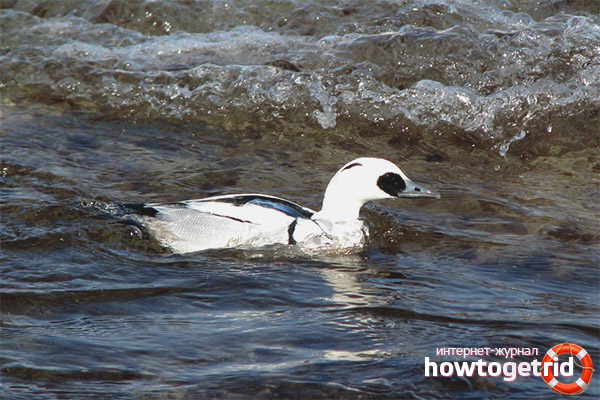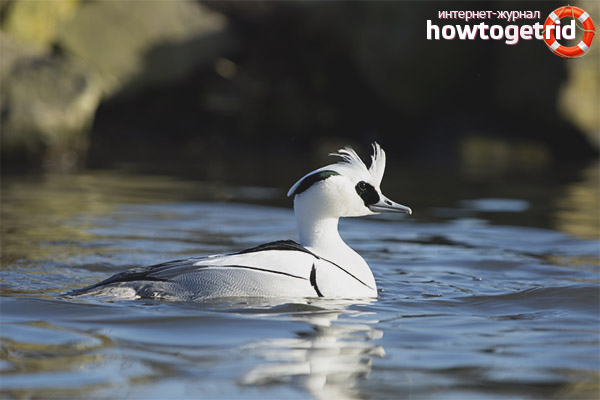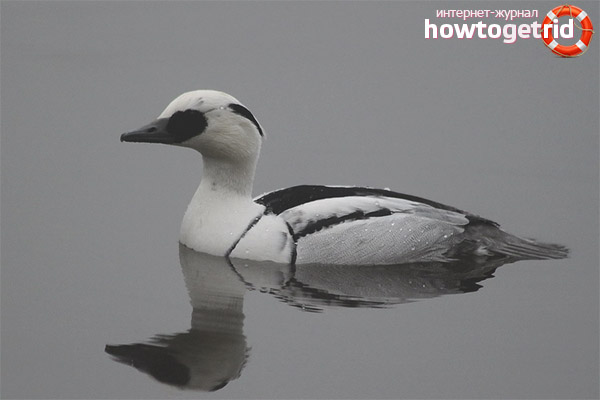The content of the article
Loot is a species of well-swimming ducks. These are wild birds; they are not bred or kept in households. Loot ducks are very popular due to their beautiful and interesting appearance. In addition, these individuals have one feature - they are an intermediate link between two different types of ducks: gogly and crumbs. That is why the loot has the features of one and the other breed in its appearance.
Breed characteristics
The second name for duck duck is white gogol. You can meet these beautiful birds in the territories of the Far East, in the northern part of Europe, as well as in Siberia. They inhabit mainly in reservoirs with fresh water. In our country, these ducks occupy taiga zones, and in the cold season fly away for wintering to the Sea of Okhotsk, Japan and the Caspian Sea, which do not freeze all year round. Distinctive features of these birds are the average body size, light and quite motley color of feathers, as well as a beautiful profile of the head. Duck ducks dive well, and one can also note their excellent swimming skills with the tail down.
Appearance
While the breeding season is passing in birds of this species, representatives of the male half have a bright and motley color. The main part of the plumage is white, which is complemented by black patterns. Females have a simpler and calmer color. The back of the females is completely gray, and the head is covered with completely red feathers, the rest of the body also has a white plumage. The legs of these ducks are mostly gray. Males can be distinguished from females by a pronounced crest on the head.
Birds at a very young age, even before the first change of plumage, have the same color, approximately the same as in adult females. The only difference in young individuals is the gray sides and goiter. It is worth noting that the males are more rapid growth and development than the female half, and therefore in size is much larger.
How do they breed?
After the wintering period, the lutes return back to the same place where they previously lived, but in pairs. Nests are built mainly in hollows of trees located not far from freshwater bodies of water. Only feathers are used as litter, in contrast to the nests of many other birds. Female eggs are laid mainly at the beginning of the first summer month. The average clutch is 8-9 eggs. However, quite often gogol lays their eggs in the nests of loot, so females sometimes have to hatch more eggs.
From the moment of laying the eggs until the appearance of the chicks, exactly a month passes. The males spend the first half of the term with the female, and then leave her. For the last two weeks, the female has to press very tightly against the eggs in order to retain heat as much as possible. The chicks that appeared on the bill arrive only in the first few hours in the nest. Then they follow to the nearest body of water right after their mother. The development and growth of chicks of loot occurs rather quickly, already 10 days after hatching, they can fly independently.
Where do they live and how do they live?
Compared to other species of waterfowl, the lout differs in that it feeds not on fish, but on various insects that live in the water.Most often, these are various bugs, dragonflies, mosquito larvae and caddis flies. In addition, sometimes ducks eat various plants and amphibians. These birds eat fish very rarely, mainly in the early spring or winter, when there is no other food. For living, the loot most often chooses lakes or ponds with fresh water in the forest. Also, sometimes they can be found in the floodplains of shallow rivers or in the area of sphagnum bogs. These birds spend the winter in the area of warm seas or large non-freezing rivers and lakes.
In Russia, wintering stocks can be found on the shores of the Sea of Okhotsk, in the Yenisei valleys, in the Anadyr River Basin, on the Rybinsk Reservoir, in the Indigirka River Valley, as well as Transbaikalia and Amur Region. Outside of our country, birds of this breed can be found in Sweden and Finland. Loot hibernates, as a rule, in the southeast of Asia, on the Japanese islands, in the north of Hindustan and in the Mediterranean.
Molting

Like most birds, twice a year the loot steadily molts. As a rule, this happens in the fall and summer. In the summer, feathers change almost completely, but in the fall, molting is more likely partial, feathers change in the area of the tail and wings. For the first time in their life, young individuals begin to molt in the fall, in September. Older adults usually molt in October.
Duck behavior
Loot Hunt
Hunters are very fond of Loot. Officially hunting for this species of birds is allowed, so it is quite popular among hunters. As a rule, the season begins at a time when birds fly to warmer territories for wintering. In order to lure the loot, hunters traditionally use stuffed birds. Observing the behavior of these birds in vivo is quite interesting, so if you have such an opportunity, do not miss it.
Video: Loot (Mergellus albellus)











Submit